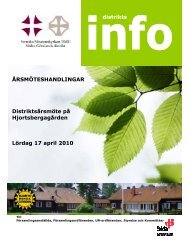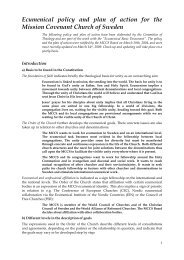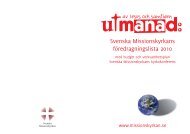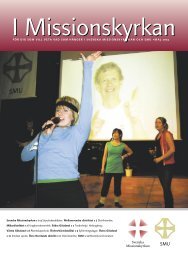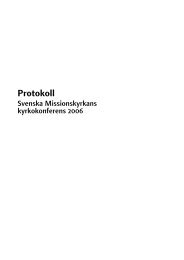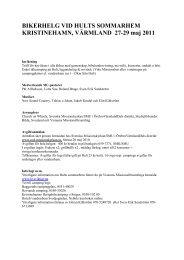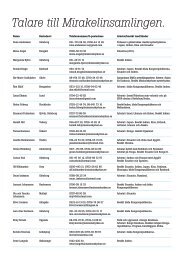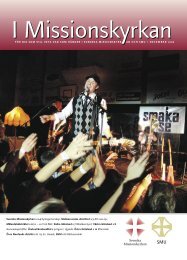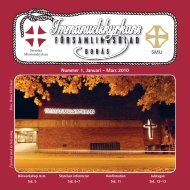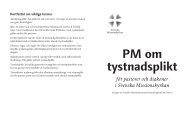Mission and Revolution in Central Asia - Svenska Missionskyrkan
Mission and Revolution in Central Asia - Svenska Missionskyrkan
Mission and Revolution in Central Asia - Svenska Missionskyrkan
Create successful ePaper yourself
Turn your PDF publications into a flip-book with our unique Google optimized e-Paper software.
e able to represent a large number of relatives. These relatives would later on have the<br />
privilege to live near this holy man. Very often everyth<strong>in</strong>g a person owned was sold to make<br />
possible this pilgrimage for oneself or to give someone else the chance to go. For he who<br />
could not travel himself but who helped <strong>in</strong> equipp<strong>in</strong>g some-body else for the trip could expect<br />
all the bless<strong>in</strong>g bestowed on the pilgrim. 168 Still, there were quite a few pilgrims leav<strong>in</strong>g from<br />
Eastern Turkestan. Raquette mentions that several hundred Muslims left for Mecca from<br />
Jark<strong>and</strong> every year. 169 Sometimes husb<strong>and</strong> <strong>and</strong> wife would travel together.<br />
It also happened that Muslims converted to Christianity made the pilgrimage. Törnquist<br />
knew of a Christian man from Kashgar who travelled to Mecca <strong>and</strong> who died there. Nobody<br />
knows if he kept his Christian faith until the end, but to his Muslim friends this pilgrimage<br />
was <strong>in</strong>terpreted as a return to Islam. 170<br />
Those who were unable to go to Mecca had to be content with the numerous sa<strong>in</strong>ts’ shr<strong>in</strong>es<br />
<strong>in</strong> the country. Just outside Kashgar, for <strong>in</strong>stance, there was a famous shr<strong>in</strong>e where many<br />
people went on a pilgrimage. 171 The last request of a Muslim was to be buried somewhere<br />
next to a sa<strong>in</strong>t. But this was reserved for the rich only, s<strong>in</strong>ce such a burial-place was very<br />
expensive. 172<br />
Gunnar Hermansson once saw some 7 000-8 000 people gathered around the shr<strong>in</strong>e of a<br />
local sa<strong>in</strong>t. He underst<strong>and</strong>s this sa<strong>in</strong>t cult as people’s need for a mediator. Allah was so far<br />
away <strong>and</strong> so <strong>in</strong>different to the needs of ord<strong>in</strong>ary people! People were look<strong>in</strong>g for a l<strong>in</strong>k,<br />
someone close to them who could also reach God. 173<br />
Accord<strong>in</strong>g to the popular beliefs, the demons, or the “j<strong>in</strong>ns” <strong>in</strong> the local language could<br />
sometimes appear <strong>in</strong> human forms. They were recognized by the way their eye slits were<br />
vertical, not horizontal as is the case with normal human be<strong>in</strong>gs. 174 The missionaries also<br />
mention people who were possessed by evil spirits.<br />
All boys were circumcised. It was usually the barber who was asked to perform the<br />
circumcision. It did happen, though, that parents came to the <strong>Mission</strong> cl<strong>in</strong>ics to have this<br />
operation done. Raquette mentions that he performed this operation on several occasions. The<br />
reason why parents turned to the missionaries <strong>in</strong> such an important <strong>and</strong> holy matter was<br />
accord<strong>in</strong>g to Raquette, that the operation at the <strong>Mission</strong> would be done <strong>in</strong> a pa<strong>in</strong>less way <strong>and</strong><br />
that the subsequent very common <strong>in</strong>flammation could be avoided. 175 The very fact that<br />
Muslims contacted the missionaries <strong>in</strong> this important matter proves that the contact between<br />
them was very good. It was, of course, surpris<strong>in</strong>g that a Muslim could allow this rite to be<br />
h<strong>and</strong>ed over to “an <strong>in</strong>fidel” <strong>and</strong>, moreover, a Christian missionary. It also gives evidence of<br />
freedom from prejudice among the missionaries. The circumcision was a ritual celebration<br />
with<strong>in</strong> a religion that the missionaries had come to abolish. But <strong>in</strong> this particular matter they<br />
met people half way, although it took a lot of will-power to do it.<br />
Eastern Turkestan Muslims were fatalists. This could be observed everywhere. Writ<strong>in</strong>g<br />
about Jarkend <strong>in</strong> 1901 Albert Andersson says that it was “repulsive <strong>in</strong> its ugl<strong>in</strong>ess …. I have<br />
never seen such a lot of jerry-built crow’s nests.” He believed that the decay had to do with<br />
the Muslims be<strong>in</strong>g held down by their faith. They felt that their fate was poverty <strong>and</strong> misery;<br />
168 Ibid., p. 29.<br />
169 Broomhall, 1910, p. 251.<br />
170 Törnquist to Sjöholm, February 19th, 1908.<br />
171 Palmaer, 1942, p. 29.<br />
172 Lundahl, 1917, p. 227 f.<br />
173 Ungdomsvännen, 1929, p. 562 <strong>and</strong> 1930, p. 230.<br />
174 Raquette, 1935, p. 135.<br />
175 Ibid., note, p. 129 f.<br />
21



